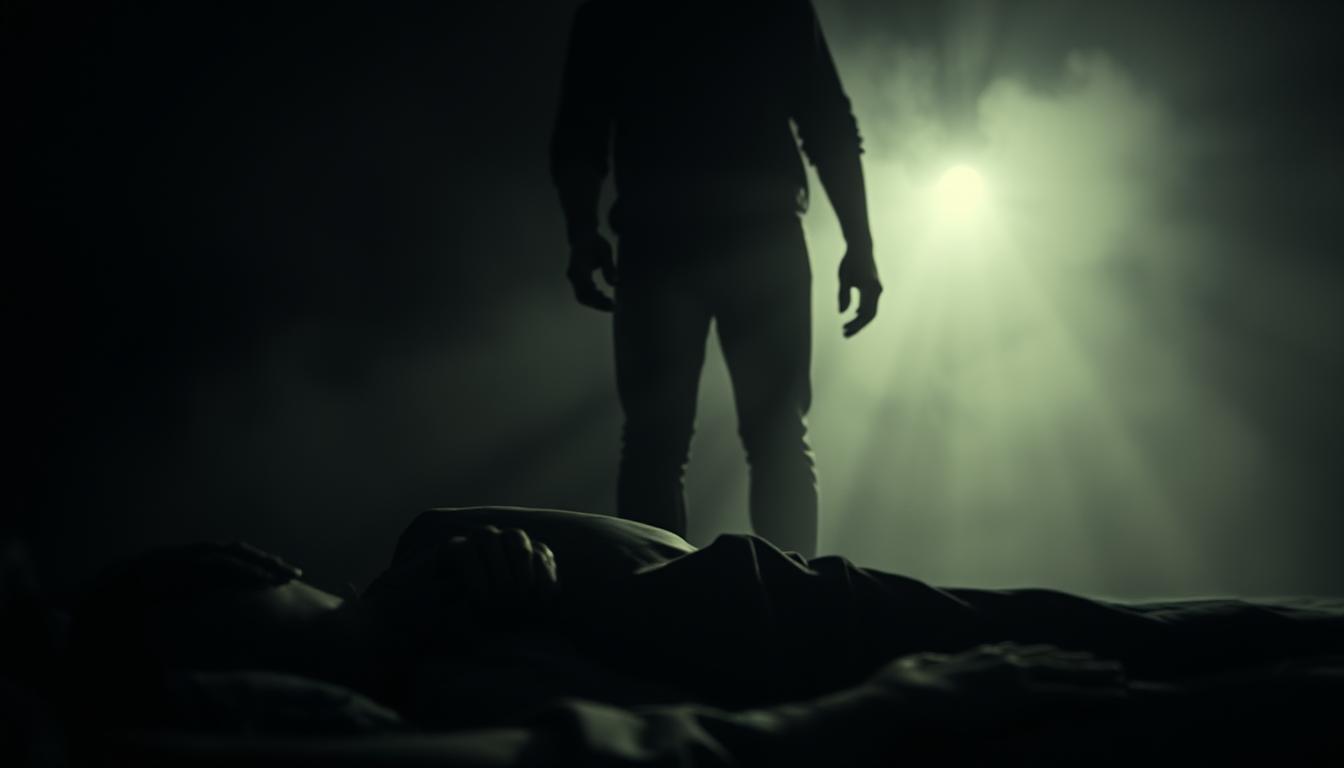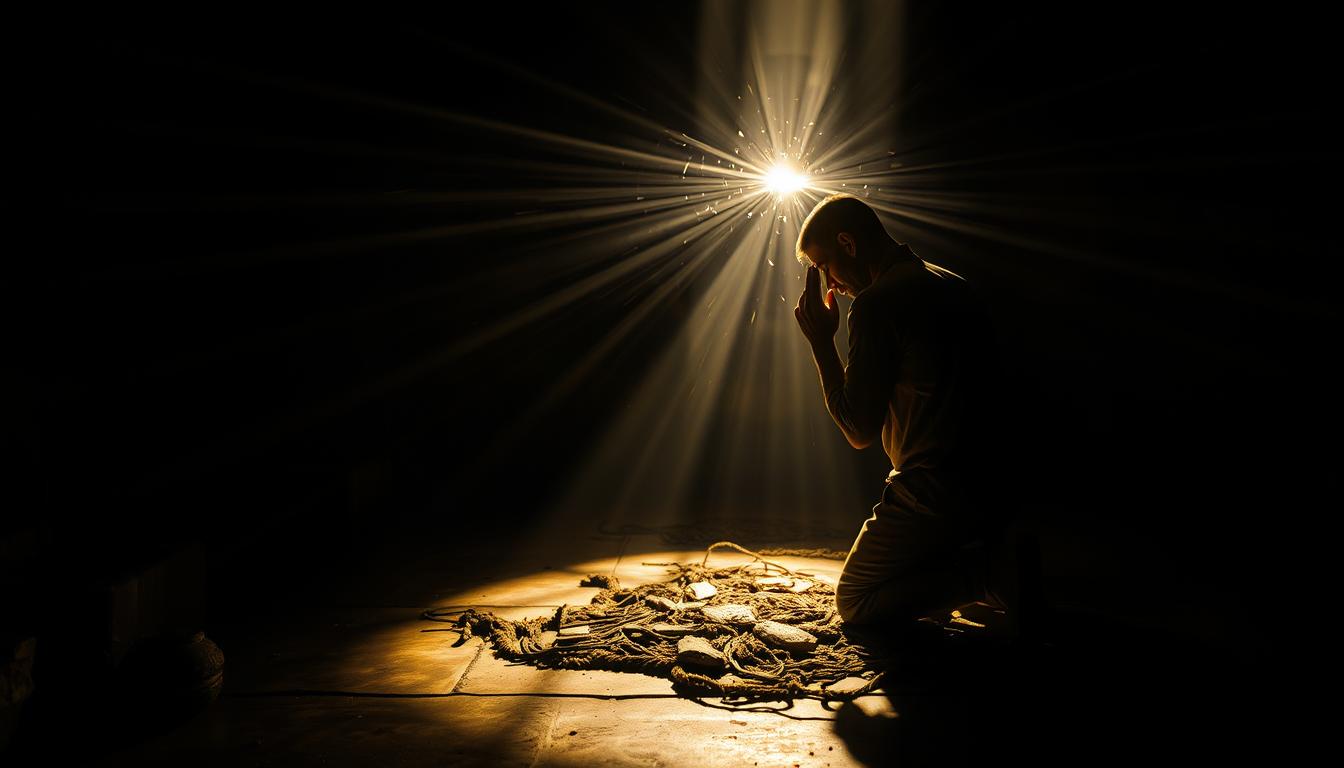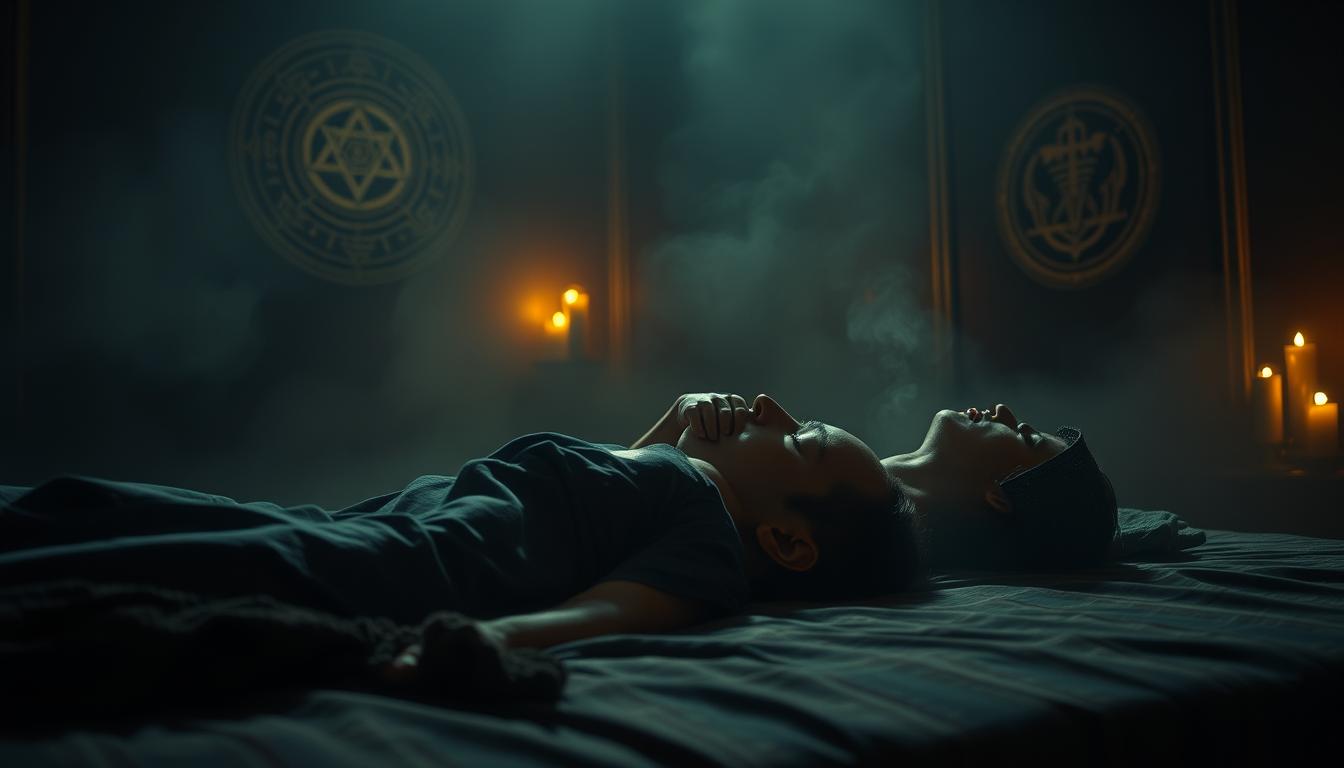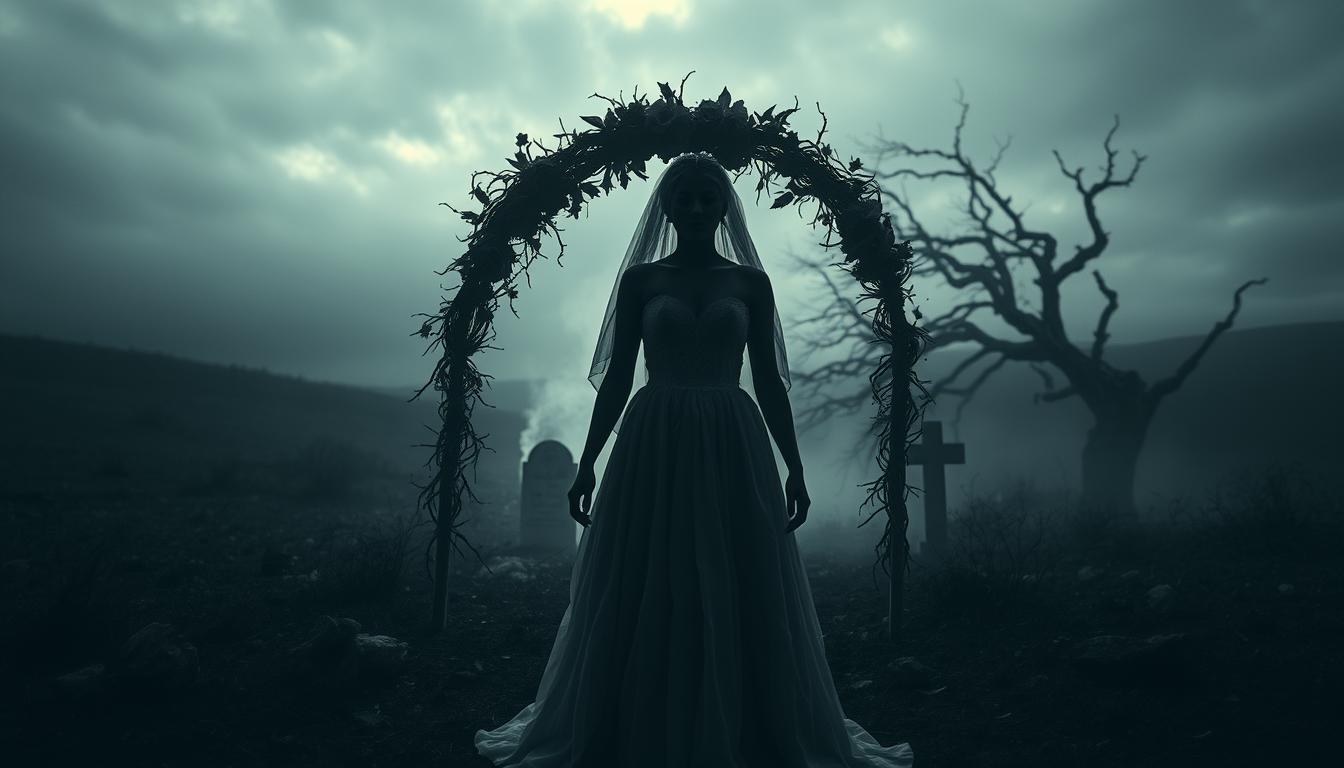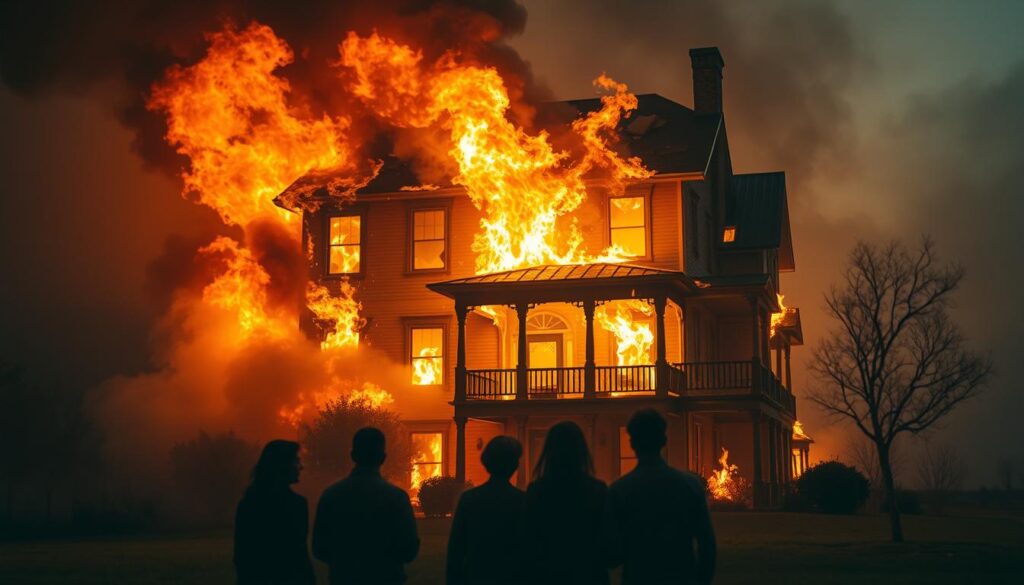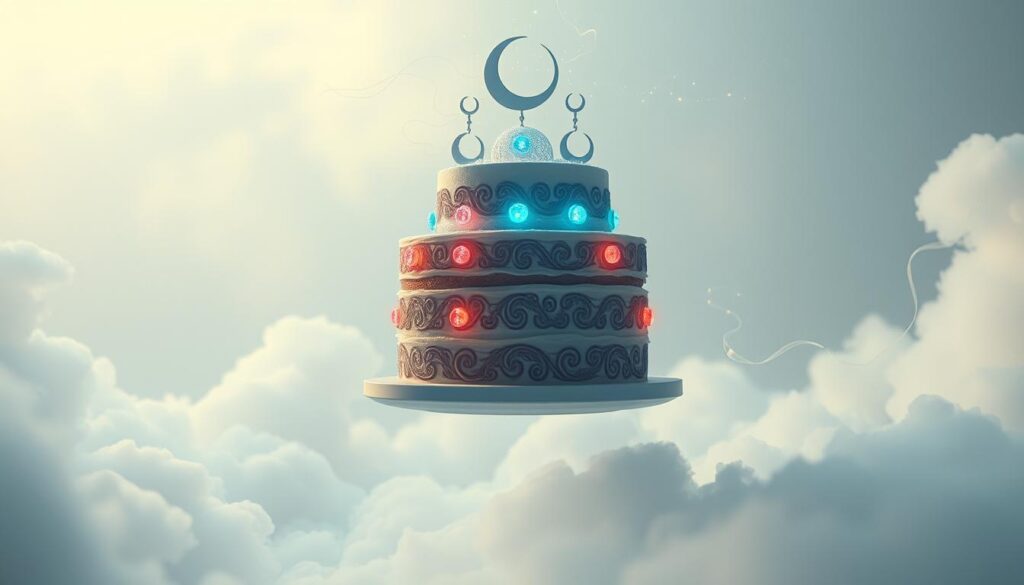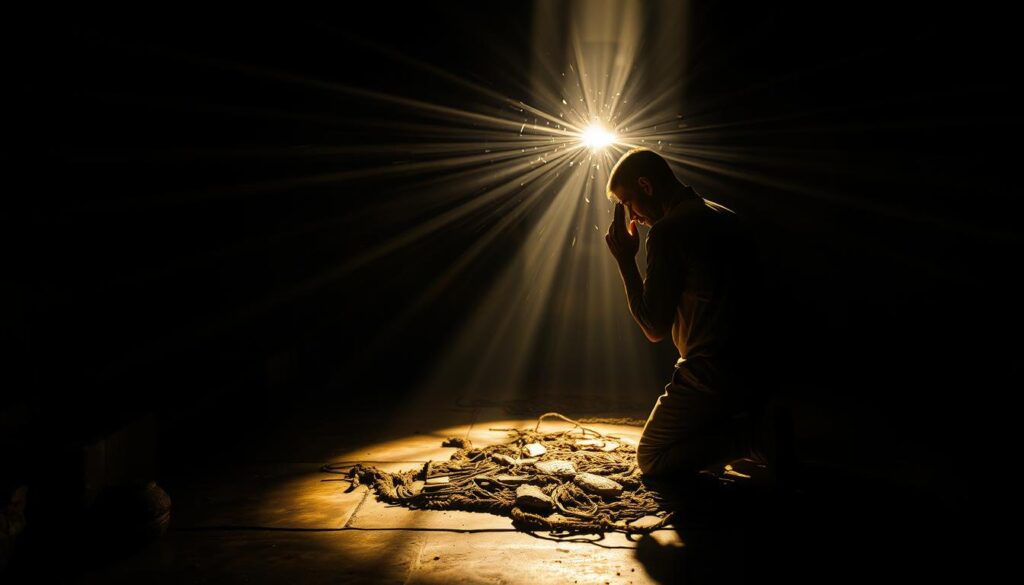Murder dreams show us deep insights into our subconscious fears and emotions. These dreams are not about real violence but are symbolic messages. They help our minds deal with unresolved conflicts.
Dreams about murder often come from deep emotional stress. They are about big changes in our minds, not real dangers. These dreams might tell us about our personal limits, how we relate to others, or inner struggles for power.
When someone tries to kill you in a dream, it shows deep emotional weakness. It might mean you’re feeling anxious, have unfinished business with someone, or facing big changes that make you feel unsafe.
Looking into murder dreams is more than just facing fear. They often mean “death” in a metaphorical sense. This could be ending bad relationships, letting go of old selves, or healing from hidden emotional pain.
To understand these dreams, we need to think deeply about ourselves. Each dream has its own meaning, showing us our deepest feelings and hidden conflicts.
Understanding the Psychology Behind Murder Dreams

Dream psychology uncovers deep emotional landscapes in our subconscious. Murder dreams show our inner struggles, revealing emotions we hide during the day.
Violent dreams aren’t about real harm but symbolize intense feelings. They offer a peek into our mental health, acting as a secret message from our subconscious.
Common Psychological Triggers
Stress nightmares come from deep fears and anxieties. Certain triggers include:
- Unresolved personal conflicts
- Suppressed emotional trauma
- Intense workplace or relationship pressures
- Unexpressed feelings of vulnerability
The Role of Daily Stress and Anxiety
Anxiety in dreams shows up in violent scenes when stress is too much. Our brain uses dreams to deal with tough emotions.
Studies show stress makes violent dreams more common. It’s like our brain is creating a safe place to face hard feelings.
Subconscious Fear Processing
Dreams help us understand complex emotions. Murder dreams often mean the end of old patterns or relationships, not real violence.
Grasping these dreams needs a careful look at our subconscious signals. Experts say violent dreams show deep changes within us.
The Symbolism of Death in Dreams – Beyond Physical Harm
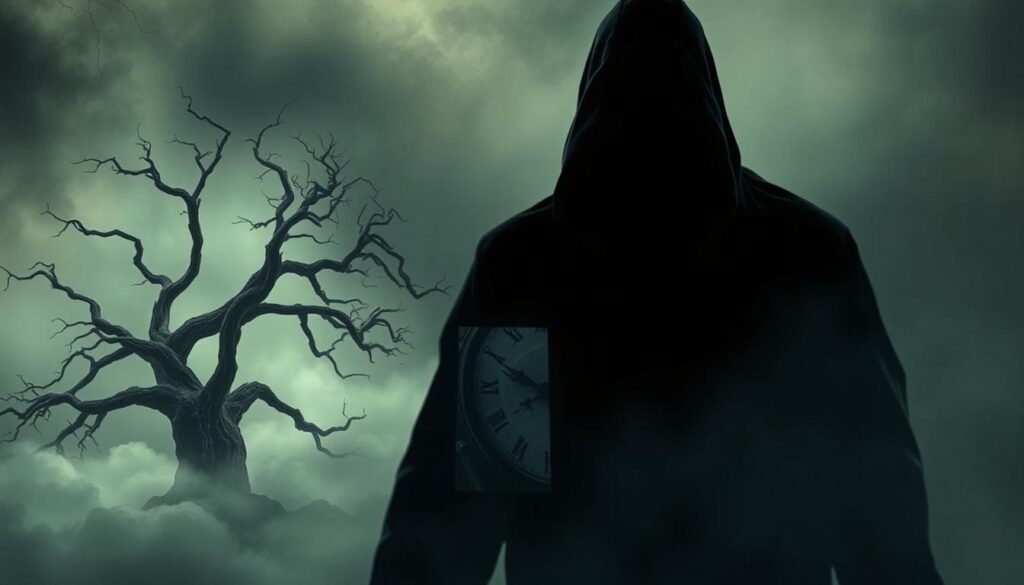
Dreams about death can make us feel uneasy, but they’re not always as simple as they appear. In dream interpretation, death is more than just an end. It’s a sign of big changes and personal growth.
Death in dreams usually means a big change in your mind. When your subconscious shows death, it’s warning you about something deeper. It’s like your inner self saying, “Time to move on.”
- Symbolic death means emotional rebirth
- Signals the end of a life phase
- Indicates possible personal growth
- Suggests readiness for change
Experts say death in dreams shows inner changes. You might be dealing with:
- Career changes
- Relationship shifts
- Personal identity growth
- Letting go of old beliefs
If you’re having these dreams, don’t worry. They usually mean you’re ready to leave old habits behind. You’re open to new chances for growth.
What Does It Mean If You Dream About Someone Killing You
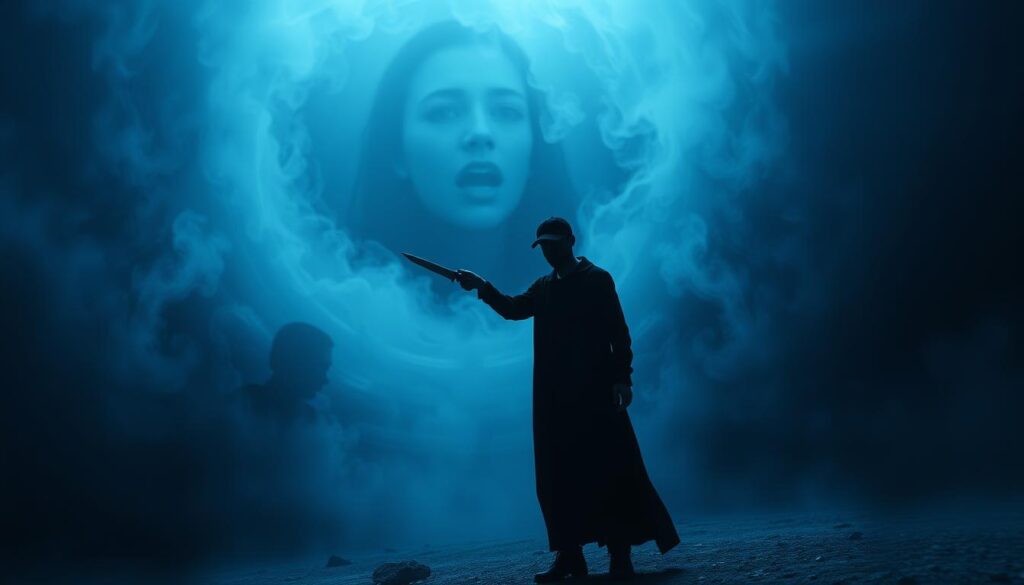
Dreams about murder can be very unsettling. They show deep connections between our fears and emotions. These dreams often symbolize inner struggles, not real threats.
Understanding murder dreams needs careful emotional study. The identity of the killer is key to uncovering hidden messages.
Analyzing Different Murder Scenarios
Murder dreams come in many forms, each with its own meaning:
- Being chased by a killer
- Witnessing a murder
- Being the victim of an attack
- Defending yourself against an assailant
Interpreting the Killer’s Identity
The killer in your dream often stands for parts of you or your relationships. Experts say dream characters mirror our inner selves.
| Killer Type | Potential Psychological Meaning |
|---|---|
| Stranger | Unknown fears or anxieties |
| Familiar Person | Unresolved interpersonal conflicts |
| Yourself | Internal self-destructive patterns |
Your Emotional Response During the Dream
How you feel in a murder dream is very telling. Fear, paralysis, or unexpected calmness can reveal a lot about your subconscious.
Noticing your immediate reactions can help understand the dream’s true meaning. Dream analysts suggest keeping a record of these intense feelings for a deeper analysis.
Recurring Murder Dreams: Pattern Recognition and Mental Health

Recurring nightmares about murder can be very unsettling. They might show important signs of mental health. These dreams often reflect deep emotional experiences and unresolved fears.
To understand these nightmares, we need to observe them closely. Experts say to watch for certain signs. These signs can tell us a lot about our mental state:
- How often the dream happens
- The story or setting of the dream
- The strong feelings during and after the dream
- What might trigger these dreams in our daily lives
Dreams about murder can come from many places in our minds. Stress, unresolved conflicts, and hidden emotional pain often show up in these dreams. Studies suggest these dreams might be our brain’s way of dealing with tough emotions.
Some key signs in these dreams include:
- Feeling always on edge
- Having unhandled personal issues
- Fear of being betrayed
- Hidden emotional scars
Getting to the bottom of these dreams needs a careful look. Talking to a mental health expert can help. They can help us understand what these dreams mean and how to heal.
When Familiar Faces Become Killers: Processing Relationship Issues

Dreams where people you know turn violent can be really scary. These dreams show us the hidden feelings we have in our relationships. They help us understand trust issues and emotional tensions we might not see.
To understand dream betrayal, we need to look at the feelings behind these scary dreams. Dreams where loved ones seem threatening often show deep psychological struggles.
Family Dynamics in Threatening Dream Scenarios
When family members attack in dreams, it might mean:
- Unresolved childhood emotional wounds
- Suppressed feelings of anger or resentment
- Subconscious fears about family relationships
These dreams usually show internal emotional struggles more than real threats from family.
Professional Relationships in Dream Conflicts
Dreams with friends or colleagues as threats often reveal:
- Work-related stress and competition
- Perceived betrayals in professional environments
- Unexpressed interpersonal tensions
Romantic Partners as Dream Attackers
When your romantic partner seems threatening in dreams, it might mean:
- Deep-seated trust issues in relationships
- Fear of emotional vulnerability
- Subconscious concerns about partner’s true intentions
These dreams are like warnings from our subconscious. They push us to think deeply and talk openly about our feelings.
Survival Instincts: Fight or Flight Responses in Dreams

Dreams offer a deep look into our instinctual responses. In survival dreams, your brain uses fight or flight to show what’s going on inside. This reveals a lot about your emotional state.
Studies show that fight or flight in dreams is more than just nighttime stories. These dreams connect to our basic survival needs. They turn psychological stress into real dream stories.
- Physiological reactions during survival dreams mirror real-world stress responses
- Instinctual responses in dreams can signal underlying emotional challenges
- Dreams help process complex psychological experiences through symbolic scenarios
In dreams, your brain’s survival mode works in special ways. Instinctual responses show up as clear scenes. You might run, hide, or face off against dream threats. This shows how your subconscious deals with challenges.
| Dream Response Type | Psychological Interpretation | Potential Trigger |
|---|---|---|
| Fighting Back | Assertiveness and self-protection | Work stress or personal conflict |
| Running Away | Avoidance of uncomfortable situations | Unresolved emotional challenges |
| Freezing | Overwhelming anxiety or powerlessness | Past trauma or current uncertainty |
Grasping these dream survival scenarios sheds light on your mental strength and how you handle emotions.
Hidden Betrayal: Uncovering Trust Issues Through Dreams

Dreams about betrayal show deep trust issues in relationships. These issues often hide in our subconscious. Dream betrayal analysis lets us see our deep fears and emotional patterns.
Understanding dreams can help us deal with complex emotions. Dreams are a way our mind processes trauma and explores relationship dynamics.
Signs of Emotional Manipulation
Emotional manipulation in dreams uses specific symbols. Knowing these signs helps us spot trust issues:
- Feeling powerless or trapped in dream scenarios
- Experiencing sudden betrayal by trusted dream figures
- Recurring dreams with themes of abandonment
Identifying Relationship Red Flags
| Dream Scenario | Potential Relationship Warning |
|---|---|
| Being stalked or threatened | Potential boundary violations |
| Partner transforming unexpectedly | Hidden personality aspects |
| Feeling trapped or controlled | Signs of emotional domination |
Processing Past Trauma
Dreams help us process past trauma safely. Nighttime narratives create a protective psychological space. Here, we can examine complex emotions without fear of real-world consequences.
- Recognize dream patterns
- Journal emotional responses
- Seek professional guidance if dreams persist
Cultural and Religious Interpretations of Death Dreams

Dreams about death have deep meanings in many cultures and religions. They show a rich tapestry of symbols that go beyond simple death. Each religion has its own way of seeing these dreams.
Many cultures see death in dreams in their own special ways:
- In Native American cultures, death dreams often symbolize spiritual transformation instead of real death
- Islamic traditions see such dreams as warnings or messages from God
- Hindu philosophy believes death dreams show big changes in life
Eastern philosophies look at death dreams with deep spiritual insight. Chinese culture thinks death dreams mean growth or big changes in life. This is different from Western views, which often see dreams as signs of trauma or fear.
Religious dreams offer complex ways to understand these dreams. In Judeo-Christian traditions, death dreams are seen as signs of rebirth or spiritual awakening. African spiritual practices see these dreams as messages from ancestors, linking the physical and spiritual worlds.
The meaning of death in dreams shows how culture shapes our views of dreams. Each tradition gives us a special way to see the hidden meanings in our dreams.
The Connection Between Murder Dreams and Personal Transformation

Dreams about murder can be shocking. Yet, they often show powerful personal transformation. These dreams reveal deep subconscious changes that signal significant psychological growth.
Dream transformation symbolism goes beyond literal meaning. When you dream of murder, your subconscious might be saying you want to get rid of old parts of yourself or your life.
- Symbolic death represents radical personal reinvention
- Killing represents releasing negative patterns
- Violent dream scenarios indicate internal struggle for change
Personal growth through dreams is like a metaphorical destruction of old beliefs. Your mind uses dramatic images to push you toward psychological evolution.
| Dream Element | Psychological Meaning |
|---|---|
| Murder Scene | Transformation trigger |
| Killer’s Identity | Internal conflict source |
| Your Reaction | Readiness for change |
Understanding these dream symbols can unlock powerful insights into your subconscious change mechanisms. The violent imagery is like a wake-up call. It pushes you to confront and release outdated versions of yourself.
By recognizing the transformative power of such dreams, you can use their energy for meaningful personal development and self-discovery.
Analyzing Your Environment: External Factors Influencing Murder Dreams
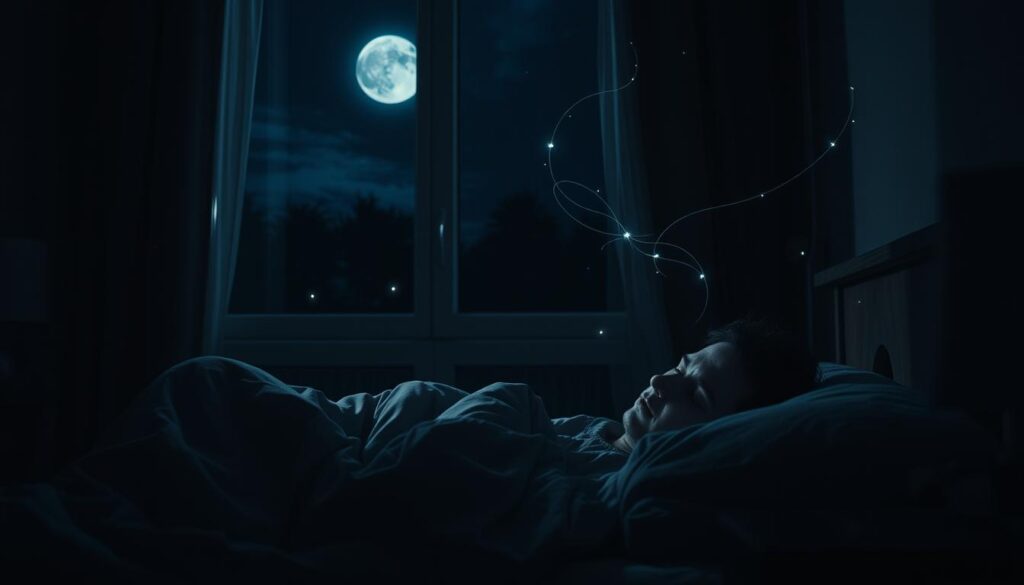
Dreams reflect our daily lives and inner battles. They show how our surroundings shape our dreams, like those scary ones about murder.
Our minds soak up many things from outside. This helps us understand our dreams better, like why we dream about murder.
Impact of Media Consumption
What we watch and hear affects our dreams. Movies, news, and social media can make our dreams intense.
- Violent TV shows increase likelihood of stress-induced nightmares
- Crime documentaries may trigger threatening dream narratives
- Intense news coverage can create subconscious anxiety
Work-Related Stress Manifestations
Work can be very stressful. This stress often shows up in our dreams, making them scary.
- High-pressure job roles increase dream intensity
- Unresolved workplace conflicts manifest in dream scenarios
- Performance anxiety triggers subconscious threat responses
Social Pressures and Expectations
Society’s expectations shape our dreams. Perceived societal demands can lead to deep emotional responses in our dreams.
Knowing these factors helps us grasp our dreams and mental health better.
Techniques for Processing and Understanding Violent Dreams
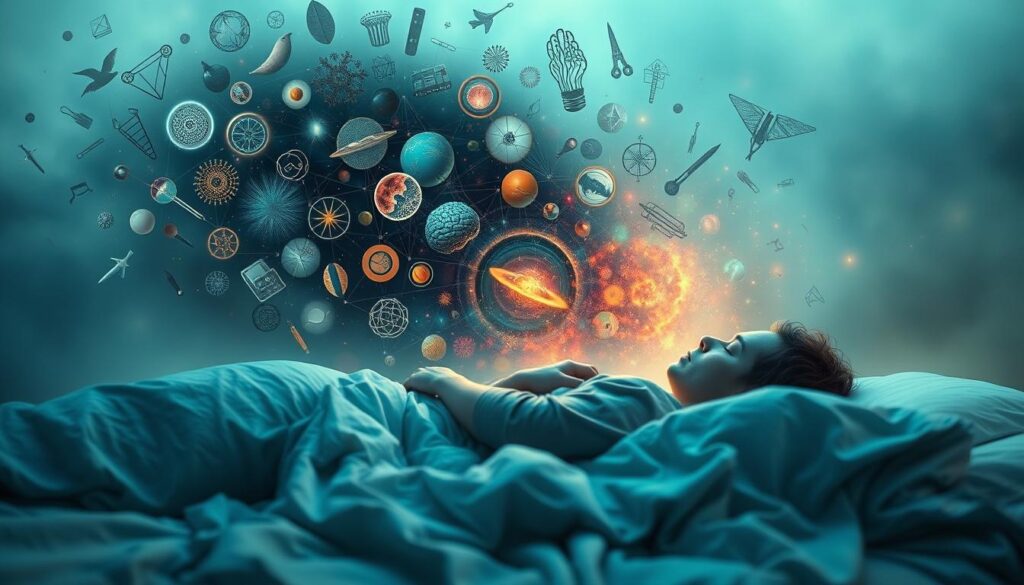
Violent dreams can be very disturbing. Learning how to analyze dreams helps you understand your mind better. It also makes these dreams less scary. By using special strategies, you can turn these dreams into lessons about yourself.
Keeping a dream journal is a great way to deal with violent dreams. It means writing down your dreams as soon as you wake up. This helps you remember the details and how you felt.
- Create a dedicated dream journal beside your bed
- Write dream details within 5 minutes of waking
- Note emotional reactions and possible triggers
- Look for recurring themes or symbolic patterns
Meditation and mindfulness can also help with violent dreams. Practicing calm breathing and visualization exercises can make you feel less anxious. They help you understand your dreams better.
Experts say looking into why you have violent dreams is important. Things like stress, unresolved issues, and hidden fears can show up in these dreams. Knowing this can help you deal with your emotions in a better way.
- Practice cognitive restructuring
- Engage in therapy or counseling
- Learn stress management techniques
- Build emotional resilience
Using these techniques and strategies can change scary dreams into chances for growth. It helps you understand yourself better.
When to Seek Professional Help for Disturbing Dreams

Recurring violent dreams can be more than just nighttime disturbances. Sometimes, these intense dream experiences signal deeper psychological challenges that require professional dream interpretation. Recognizing when to seek help is key for maintaining mental health and understanding your subconscious mind.
Professional dream therapy is vital when your dreams show these warning signs:
- Dreams frequently disrupt your sleep patterns
- Violent dream scenarios cause significant emotional distress
- Nightmares interfere with daily functioning
- You experience persistent anxiety related to dream content
Nightmare disorder presents unique challenges that professional therapists can help address. Mental health experts specializing in dream analysis can provide deep insights into the underlying psychological triggers of your disturbing dreams.
Key indicators that suggest you should consult a professional include:
- Dreams repeatedly feature graphic violence
- Emotional responses to dreams feel overwhelming
- You struggle to distinguish dream experiences from reality
- Dreams create persistent fear or paranoia
A qualified professional in dream therapy can help you:
- Decode complex dream symbolism
- Identify possible psychological stressors
- Develop coping mechanisms for intense dream experiences
- Understand the connection between dreams and emotional well-being
Professional dream interpretation offers a structured approach to understanding your subconscious mind. By seeking expert guidance, you can transform disturbing dreams from sources of anxiety into opportunities for personal growth and self-discovery.
Dream Journaling Methods for Tracking Murder Dreams
Learning to keep a dream journal changes how you see your dreams. It helps you track nightmares and understand your mind better. Start by keeping a notebook next to your bed. This way, you can write down your dreams right after waking up.
To recognize dream patterns, you need to document them well. Write down the story of your dream, how you felt, and any physical sensations. Also, note who was in your dream and where it took place. Use simple drawings or colors to show how you felt during the dream.
For those who prefer technology, there are apps and digital journals. They make it easy to organize and analyze your dreams. Try using time stamps to capture the mood of your dreams. Keeping up with this can show you recurring themes and what might be causing your nightmares.
Keeping a dream journal helps you explore your own mind. By regularly looking back at your dreams, you can understand your emotions better. It takes time and effort, but it can reveal a lot about what’s going on in your subconscious.
